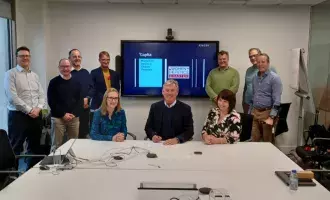These turbulent times might not look like the best time to invest in your workforce.
An uncertain economic future paired with unpredictable future skills needs make it a risk that may not seem worth taking. But the organisations to come out of the pandemic ahead of the crowd will be those who kept an eye on the future while still fulfilling their immediate staffing needs.
The contingent roles of today could well become the permanent hires of the future – but the skills and competencies offered by each can differ significantly. And the advantages also vary: immediate flexibility and long-term planning do not typically go hand in hand.
A custom-built capability framework is commonly used to drive long-term recruitment. Outlining roles, skills and competencies against your strategic goals and business objectives, it provides a pathway to your business future. However, it relies on the expectation of permanent staff: those you can train, develop, engage with your organisational vision and, most importantly, rely on. And this involves an immediate, significant investment that’ll take time to see a return, with the risk that they may never deliver it.
The demands of managing risk in a highly volatile talent market are likely to mean a greater reliance upon contingent labour. Contingents can offer a highly effective stop-gap solution, and often bring years of wide-reaching expertise, but they can’t always deliver the specialisms required by forward-thinking organisations who not only want to thrive now, but want to continue moving positively forward.
Here, a capability framework can offer real strategic gains and mitigated risk, through being paired with an outsourced Employed Resource Model, or even built alongside it. Guiding your chosen vendor’s immediate recruitment of benched workers, these are then deployed to you as consultants. The forward-facing framework then allows focussed progression of their training over time.
Within an Employed Resource Model, the right partner can develop a specific talent pool of people aligned to your capability framework and its job descriptions. The journey begins with competency-based interviews, with questions set by you for each grade and skillset defined by the framework. You can then progress to develop the workers’ skills, using the capability framework as the basis for their learning and development.
This offers a huge benefit, in that workers, if and when you take up the option to transition them to your permanent staff, have market-benchmarked capabilities which have been tried out on a contingent basis first. Having worked within your organisation, they are also culturally aligned to you, and have proven that they have both the hard and soft skills needed to thrive. This model benefits the worker, too, with their acquired experience enabling a fully engaged and informed choice to join your team.
Our Employed Resource Model has a proven history of delivering just this, for high profile organisations that need to get their talent strategies just right. Our work with the Home Office enabled them to deploy 40 workers within 6 months, making an average 30% saving compared to alternative contingent routes and with an exceptionally high level of satisfaction from the client. With the first batch of workers expected to transition to permanent staff by the end of 2020, we’re delighted that the average feedback for each employee is 4 out of 5, frequently exceeding expectations.
We’ve been providing resources matched to Home Office’s established capability framework, immediately reducing the need for day rate contractors to fill the gaps in their internal staff capability. Development and mentoring has ensured the growth and expansion of skills, focussed on the gaps that needed filling. In the long term, we’re helping the Home Office with bolstered internal capability by transitioning these workers to permanent staff.
Satisfying today’s need for de-risked resource doesn’t need to mean compromising tomorrow’s requirement for specialised, strategised talent. We can help you build, borrow and buy skills, in perfect alignment with the future you’re working towards. Learn more about our ERM model.

Jessica Holt
Director, Capita Resourcing’s Consultancy & Workforce Solution
Jessica is the Director of Capita Resourcing’s Consultancy & Workforce Solutions, responsible for the Employed Resource Model and Novus Programme delivering over 300 consultants to 50 public and private sector customers within the UK.

Tom Christmas
Client Solutions Director, Capita Resourcing
Tom is responsible for strategic accounts across Capita Resourcing’s Consulting Tower. Tom currently delivers large scale Employed Resource and Novus Services to both public and private sector clients.







